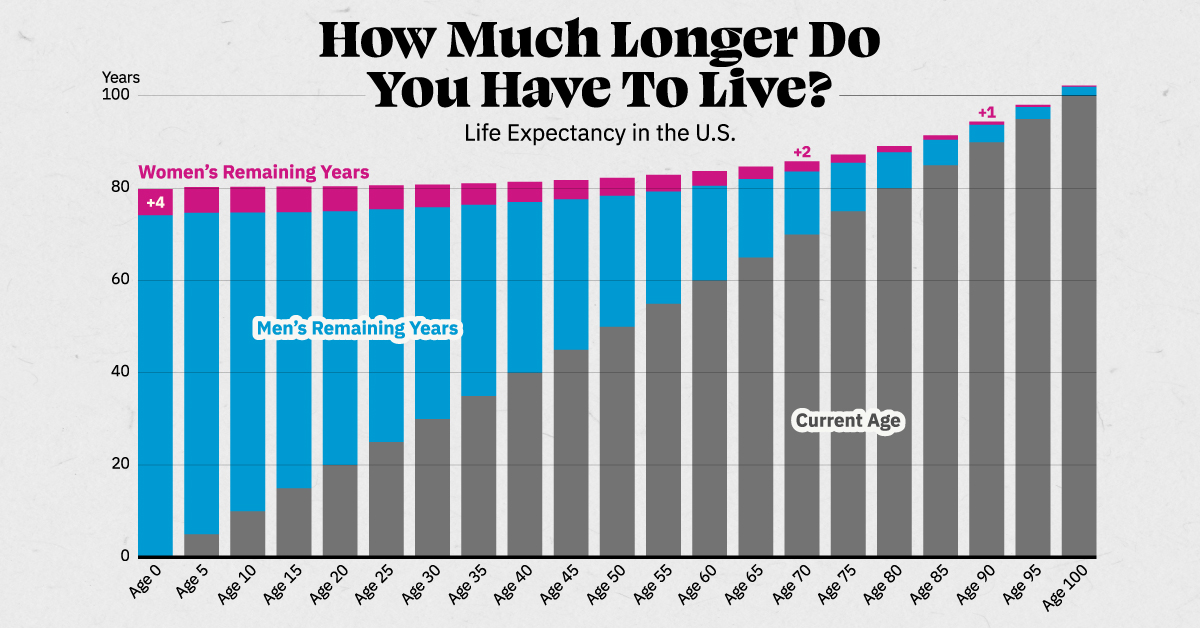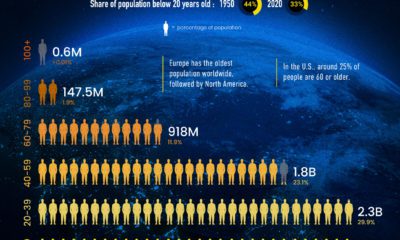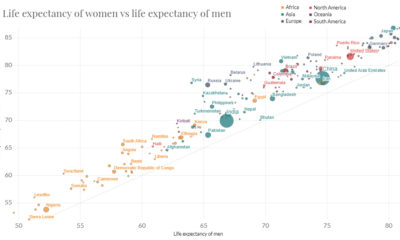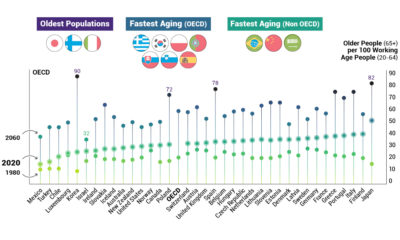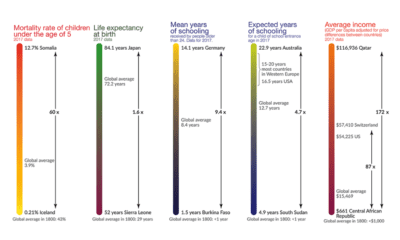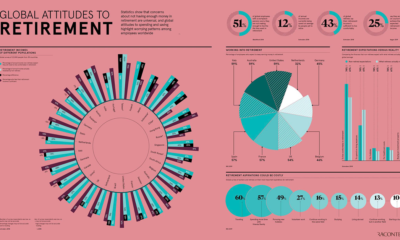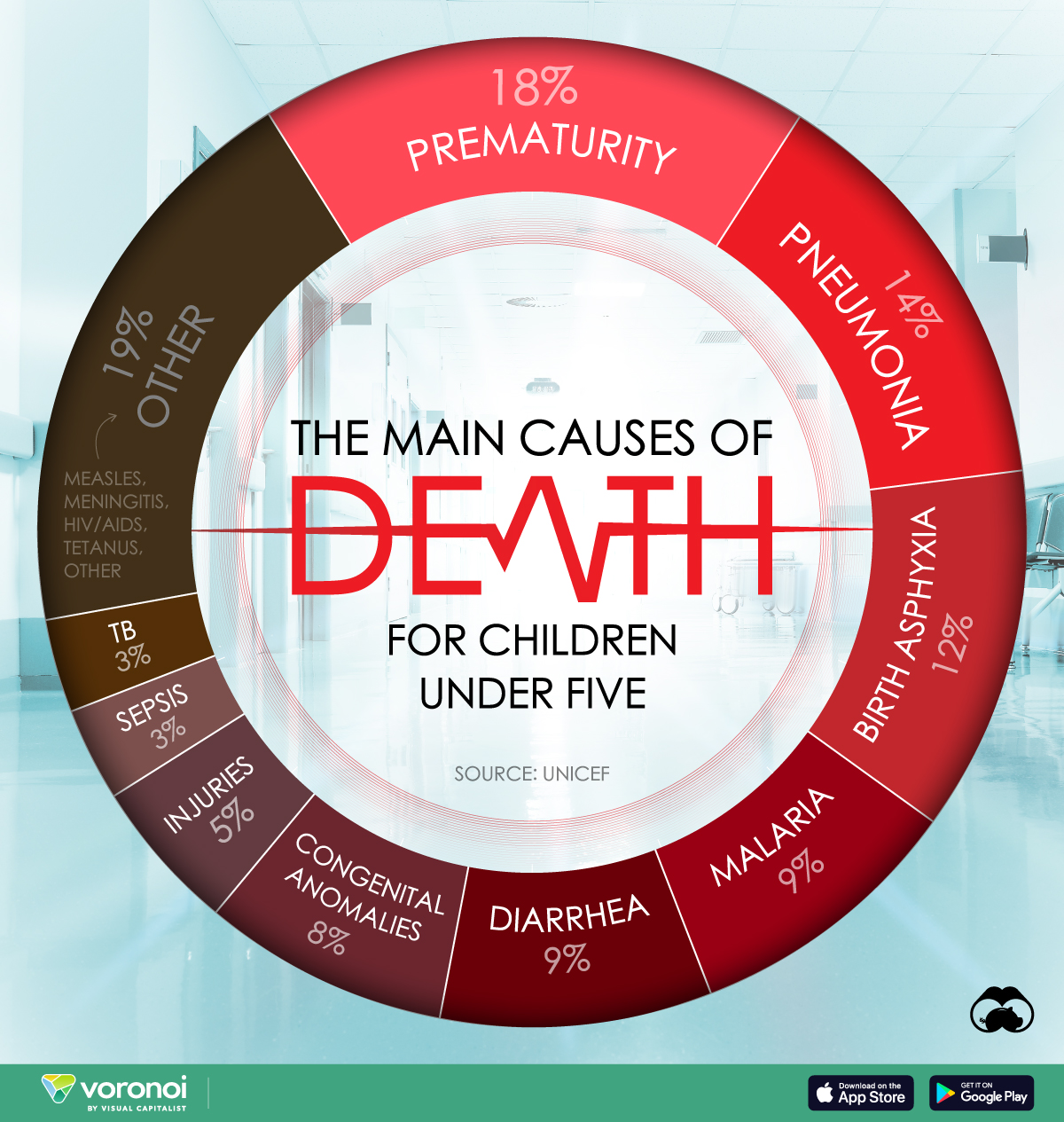Healthcare
Charted: Average Years Left to Live by Age
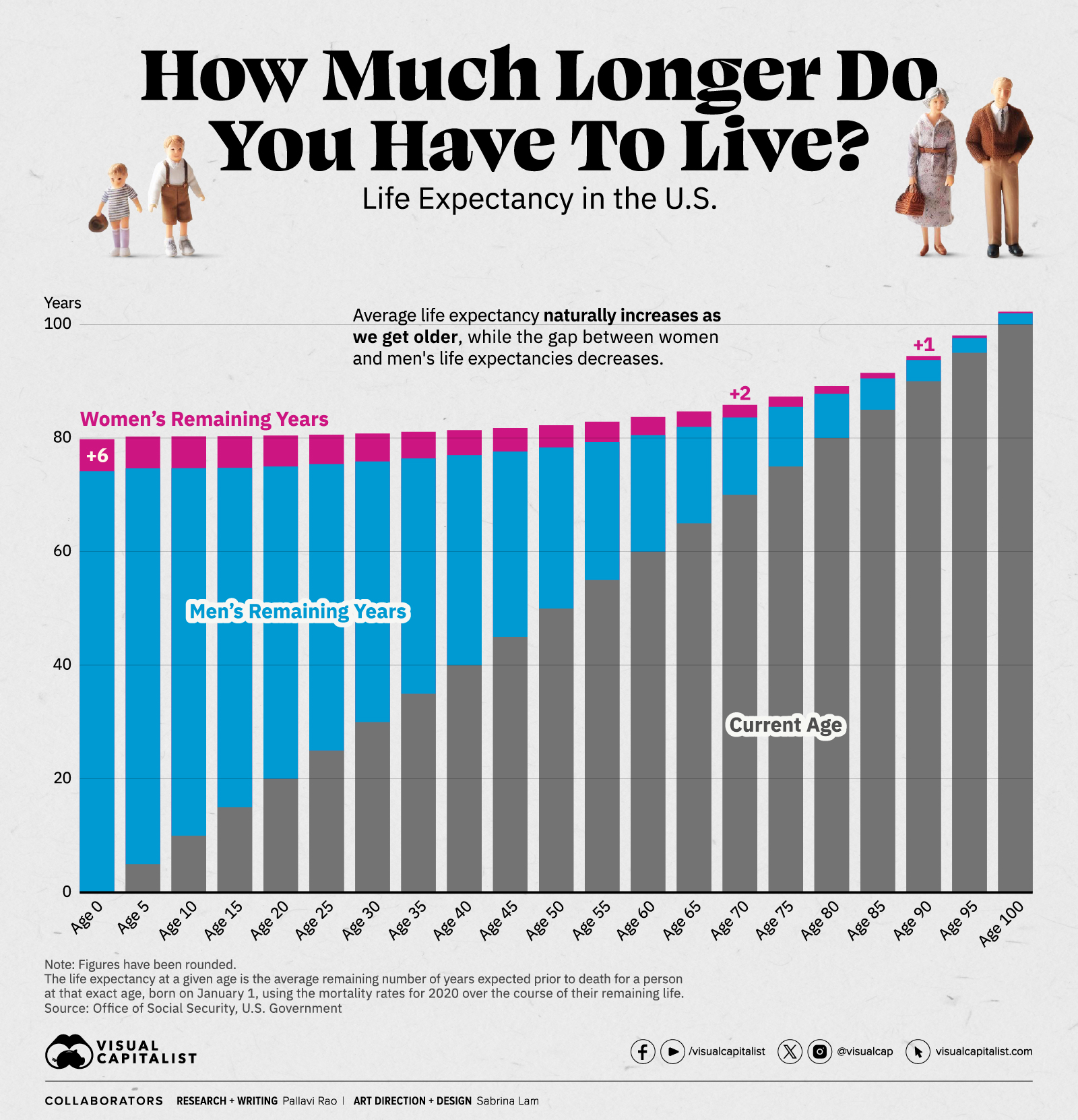
How Many Years Do You Have Left to Live?
At the start of the 19th century, when there fewer than 1 billion humans on the earth, global life expectancy at birth stood at roughly 29 years.
This is a startlingly low figure—because life expectancy is a statistical projection of how many more years a person can expect to live, based on the mortality rates at the time. And since the infant mortality rate in particular was so high, life expectancies accurately summarized the low likelihood of many babies living to adulthood.
However, since the 1920s, life expectancy across all ages has improved leaps and bounds, thanks to rapid advancements in nutrition, healthcare, and sanitation.
We visualized the current American life expectancy by age and gender, using data from the Office of Social Security, which bases their current projections on 2020 mortality rates.
American Life Expectancy at Every Age
A key takeaway with life expectancy is that it increases as one gets older. This is easily seen in the table below, which lists the remaining years left to live at a given age for an American male and the projected life expectancy.
| Age | Years Remaining (Men) | Life Expectancy (Men) |
|---|---|---|
| 0 | 74.12 | 74.12 |
| 1 | 73.55 | 74.55 |
| 2 | 72.58 | 74.58 |
| 3 | 71.60 | 74.60 |
| 4 | 70.62 | 74.62 |
| 5 | 69.63 | 74.63 |
| 6 | 68.64 | 74.64 |
| 7 | 67.65 | 74.65 |
| 8 | 66.65 | 74.65 |
| 9 | 65.66 | 74.66 |
| 10 | 64.67 | 74.67 |
| 11 | 63.68 | 74.68 |
| 12 | 62.69 | 74.69 |
| 13 | 61.70 | 74.70 |
| 14 | 60.71 | 74.71 |
| 15 | 59.73 | 74.73 |
| 16 | 58.76 | 74.76 |
| 17 | 57.79 | 74.79 |
| 18 | 56.84 | 74.84 |
| 19 | 55.90 | 74.90 |
| 20 | 54.97 | 74.97 |
| 21 | 54.04 | 75.04 |
| 22 | 53.12 | 75.12 |
| 23 | 52.21 | 75.21 |
| 24 | 51.30 | 75.30 |
| 25 | 50.39 | 75.39 |
| 26 | 49.48 | 75.48 |
| 27 | 48.57 | 75.57 |
| 28 | 47.66 | 75.66 |
| 29 | 46.76 | 75.76 |
| 30 | 45.86 | 75.86 |
| 31 | 44.97 | 75.97 |
| 32 | 44.07 | 76.07 |
| 33 | 43.18 | 76.18 |
| 34 | 42.29 | 76.29 |
| 35 | 41.39 | 76.39 |
| 36 | 40.50 | 76.50 |
| 37 | 39.62 | 76.62 |
| 38 | 38.73 | 76.73 |
| 39 | 37.85 | 76.85 |
| 40 | 36.97 | 76.97 |
| 41 | 36.09 | 77.09 |
| 42 | 35.21 | 77.21 |
| 43 | 34.34 | 77.34 |
| 44 | 33.46 | 77.46 |
| 45 | 32.59 | 77.59 |
| 46 | 31.73 | 77.73 |
| 47 | 30.87 | 77.87 |
| 48 | 30.01 | 78.01 |
| 49 | 29.17 | 78.17 |
| 50 | 28.33 | 78.33 |
| 51 | 27.50 | 78.50 |
| 52 | 26.67 | 78.67 |
| 53 | 25.86 | 78.86 |
| 54 | 25.06 | 79.06 |
| 55 | 24.27 | 79.27 |
| 56 | 23.48 | 79.48 |
| 57 | 22.71 | 79.71 |
| 58 | 21.95 | 79.95 |
| 59 | 21.21 | 80.21 |
| 60 | 20.47 | 80.47 |
| 61 | 19.74 | 80.74 |
| 62 | 19.03 | 81.03 |
| 63 | 18.32 | 81.32 |
| 64 | 17.63 | 81.63 |
| 65 | 16.94 | 81.94 |
| 66 | 16.26 | 82.26 |
| 67 | 15.58 | 82.58 |
| 68 | 14.91 | 82.91 |
| 69 | 14.24 | 83.24 |
| 70 | 13.59 | 83.59 |
| 71 | 12.94 | 83.94 |
| 72 | 12.30 | 84.30 |
| 73 | 11.67 | 84.67 |
| 74 | 11.05 | 85.05 |
| 75 | 10.46 | 85.46 |
| 76 | 9.88 | 85.88 |
| 77 | 9.32 | 86.32 |
| 78 | 8.77 | 86.77 |
| 79 | 8.25 | 87.25 |
| 80 | 7.74 | 87.74 |
| 81 | 7.25 | 88.25 |
| 82 | 6.77 | 88.77 |
| 83 | 6.31 | 89.31 |
| 84 | 5.88 | 89.88 |
| 85 | 5.47 | 90.47 |
| 86 | 5.07 | 91.07 |
| 87 | 4.70 | 91.70 |
| 88 | 4.35 | 92.35 |
| 89 | 4.02 | 93.02 |
| 90 | 3.72 | 93.72 |
| 91 | 3.44 | 94.44 |
| 92 | 3.18 | 95.18 |
| 93 | 2.96 | 95.96 |
| 94 | 2.75 | 96.75 |
| 95 | 2.57 | 97.57 |
| 96 | 2.42 | 98.42 |
| 97 | 2.28 | 99.28 |
| 98 | 2.15 | 100.15 |
| 99 | 2.04 | 101.04 |
| 100 | 1.93 | 101.93 |
| 101 | 1.83 | 102.83 |
| 102 | 1.73 | 103.73 |
| 103 | 1.63 | 104.63 |
| 104 | 1.54 | 105.54 |
| 105 | 1.45 | 106.45 |
| 106 | 1.36 | 107.36 |
| 107 | 1.27 | 108.27 |
| 108 | 1.18 | 109.18 |
| 109 | 1.10 | 110.10 |
| 110 | 1.02 | 111.02 |
| 111 | 0.95 | 111.95 |
| 112 | 0.88 | 112.88 |
| 113 | 0.82 | 113.82 |
| 114 | 0.76 | 114.76 |
| 115 | 0.70 | 115.70 |
| 116 | 0.65 | 116.65 |
| 117 | 0.60 | 117.60 |
| 118 | 0.56 | 118.56 |
| 119 | 0.52 | 119.52 |
| 120 | 0.48 | 120.48 |
At birth, an average American baby boy can expect to live till just past 74. But if the boy reaches adulthood, then at 21 he might live to a full year more, past 75. This trend persists even towards the end of life when the years we have left drop rapidly, influenced by the higher likelihood of death.
American women, on the other hand, have a higher life expectancy than men. At birth the gap is close to six years, narrowing steadily to around one year by 85.
| Age | Years Remaining (Women) | Life Expectancy (Women) |
|---|---|---|
| 0 | 79.78 | 79.78 |
| 1 | 79.17 | 80.17 |
| 2 | 78.19 | 80.19 |
| 3 | 77.21 | 80.21 |
| 4 | 76.22 | 80.22 |
| 5 | 75.23 | 80.23 |
| 6 | 74.24 | 80.24 |
| 7 | 73.25 | 80.25 |
| 8 | 72.25 | 80.25 |
| 9 | 71.26 | 80.26 |
| 10 | 70.27 | 80.27 |
| 11 | 69.27 | 80.27 |
| 12 | 68.28 | 80.28 |
| 13 | 67.29 | 80.29 |
| 14 | 66.30 | 80.30 |
| 15 | 65.31 | 80.31 |
| 16 | 64.32 | 80.32 |
| 17 | 63.34 | 80.34 |
| 18 | 62.36 | 80.36 |
| 19 | 61.38 | 80.38 |
| 20 | 60.41 | 80.41 |
| 21 | 59.44 | 80.44 |
| 22 | 58.47 | 80.47 |
| 23 | 57.50 | 80.50 |
| 24 | 56.54 | 80.54 |
| 25 | 55.58 | 80.58 |
| 26 | 54.61 | 80.61 |
| 27 | 53.66 | 80.66 |
| 28 | 52.70 | 80.70 |
| 29 | 51.74 | 80.74 |
| 30 | 50.79 | 80.79 |
| 31 | 49.84 | 80.84 |
| 32 | 48.89 | 80.89 |
| 33 | 47.94 | 80.94 |
| 34 | 47.00 | 81.00 |
| 35 | 46.06 | 81.06 |
| 36 | 45.12 | 81.12 |
| 37 | 44.18 | 81.18 |
| 38 | 43.24 | 81.24 |
| 39 | 42.31 | 81.31 |
| 40 | 41.38 | 81.38 |
| 41 | 40.45 | 81.45 |
| 42 | 39.52 | 81.52 |
| 43 | 38.60 | 81.60 |
| 44 | 37.68 | 81.68 |
| 45 | 36.76 | 81.76 |
| 46 | 35.85 | 81.85 |
| 47 | 34.94 | 81.94 |
| 48 | 34.04 | 82.04 |
| 49 | 33.14 | 82.14 |
| 50 | 32.24 | 82.24 |
| 51 | 31.35 | 82.35 |
| 52 | 30.47 | 82.47 |
| 53 | 29.59 | 82.59 |
| 54 | 28.72 | 82.72 |
| 55 | 27.86 | 82.86 |
| 56 | 27.01 | 83.01 |
| 57 | 26.16 | 83.16 |
| 58 | 25.32 | 83.32 |
| 59 | 24.49 | 83.49 |
| 60 | 23.67 | 83.67 |
| 61 | 22.85 | 83.85 |
| 62 | 22.04 | 84.04 |
| 63 | 21.24 | 84.24 |
| 64 | 20.45 | 84.45 |
| 65 | 19.66 | 84.66 |
| 66 | 18.88 | 84.88 |
| 67 | 18.10 | 85.10 |
| 68 | 17.34 | 85.34 |
| 69 | 16.58 | 85.58 |
| 70 | 15.82 | 85.82 |
| 71 | 15.08 | 86.08 |
| 72 | 14.36 | 86.36 |
| 73 | 13.64 | 86.64 |
| 74 | 12.94 | 86.94 |
| 75 | 12.26 | 87.26 |
| 76 | 11.60 | 87.60 |
| 77 | 10.95 | 87.95 |
| 78 | 10.31 | 88.31 |
| 79 | 9.70 | 88.70 |
| 80 | 9.10 | 89.10 |
| 81 | 8.53 | 89.53 |
| 82 | 7.98 | 89.98 |
| 83 | 7.44 | 90.44 |
| 84 | 6.93 | 90.93 |
| 85 | 6.44 | 91.44 |
| 86 | 5.99 | 91.99 |
| 87 | 5.55 | 92.55 |
| 88 | 5.15 | 93.15 |
| 89 | 4.76 | 93.76 |
| 90 | 4.41 | 94.41 |
| 91 | 4.08 | 95.08 |
| 92 | 3.78 | 95.78 |
| 93 | 3.51 | 96.51 |
| 94 | 3.27 | 97.27 |
| 95 | 3.05 | 98.05 |
| 96 | 2.85 | 98.85 |
| 97 | 2.68 | 99.68 |
| 98 | 2.52 | 100.52 |
| 99 | 2.37 | 101.37 |
| 100 | 2.23 | 102.23 |
| 101 | 2.09 | 103.09 |
| 102 | 1.96 | 103.96 |
| 103 | 1.84 | 104.84 |
| 104 | 1.72 | 105.72 |
| 105 | 1.61 | 106.61 |
| 106 | 1.51 | 107.51 |
| 107 | 1.41 | 108.41 |
| 108 | 1.32 | 109.32 |
| 109 | 1.24 | 110.24 |
| 110 | 1.16 | 111.16 |
| 111 | 1.09 | 112.09 |
| 112 | 1.02 | 113.02 |
| 113 | 0.96 | 113.96 |
| 114 | 0.90 | 114.90 |
| 115 | 0.85 | 115.85 |
| 116 | 0.80 | 116.80 |
| 117 | 0.75 | 117.75 |
| 118 | 0.70 | 118.70 |
| 119 | 0.66 | 119.66 |
| 120 | 0.62 | 120.62 |
Interestingly, women outlive men in nearly every country in the world, due to a mix of sociological, behavioral, and biological reasons.
COVID-19: Reversing A Decade of Increasing American Life Expectancy
While the current American life expectancy at birth seems reasonably high, it is nearly two years lower than the 2022 figure which used the 2019 mortality rate. It is also lower than the life expectancy at birth in 2009, which used 2005 mortality rate.
| Year | Life Expectancy at Birth (Men) | Life Expectancy at Birth (Women) |
|---|---|---|
| 2009 | 74.12 | 79.95 |
| 2014 | 76.10 | 80.94 |
| 2019 | 76.04 | 80.99 |
| 2023 | 74.12 | 79.78 |
American mortality rates went up 17% between 2019–2020, in part because of COVID-19, in turn affecting life expectancy. The U.S. also had a higher COVID-19 mortality rate compared to its peers two years after the pandemic first struck.
Thus, American life expectancy may not improve immediately to 2019 levels, which can affect insurance premiums, pension benefits, and plans.
Where Does This Data Come From?
Source: Office of Social Security, U.S. Government.
Note: The life expectancy at a given age is the average remaining number of years expected prior to death for a person at that exact age, born on January 1, using the mortality rates for 2020 over the course of their remaining life.
Healthcare
What Causes Preventable Child Deaths?
Between 1990 and 2022, preventable child deaths more than halved. However there are still challenges to overcome.
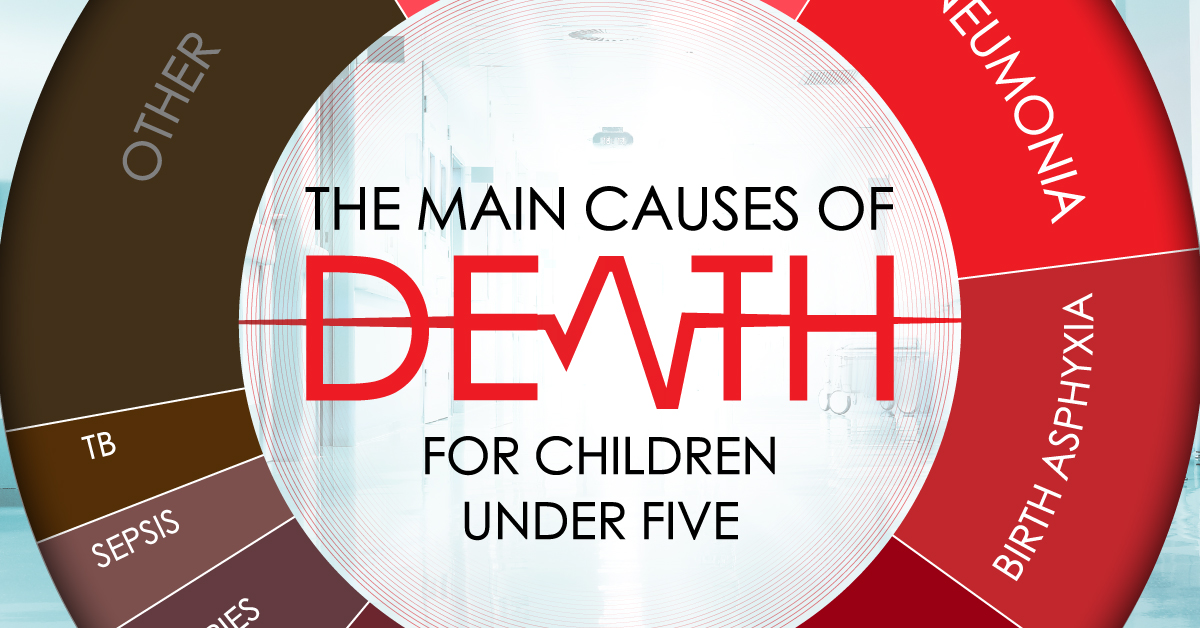
What Causes Preventable Child Deaths?
This was originally posted on our Voronoi app. Download the app for free on Apple or Android and discover incredible data-driven charts from a variety of trusted sources.
One of the often-overlooked successes of the modern era is the light-speed innovation in healthcare, easily seen in improvements in life expectancy.
The drop in infant mortality is another example. In 1990, more than 12 million preventable child deaths occurred. Three decades later, that number has more than halved. Nevertheless, despite gains, there are still challenges left to overcome.
We visualize leading causes of death in 2022 for children under the age of five according to a UNICEF report, published March 2024.
Ranked: The Causes of Death for Children Under Five
Globally, 4.9 million children under the age of five died in 2022.
| Rank | Cause | % of Global Under-Five Deaths in 2022 |
|---|---|---|
| 1 | Prematurity | 18% |
| 2 | Pneumonia | 14% |
| 3 | Birth Asphyxia | 12% |
| 4 | Malaria | 9% |
| 5 | Diarrhea | 9% |
| 6 | Congenital Anomalies | 8% |
| 7 | Injuries | 5% |
| 8 | Sepsis | 3% |
| 9 | Tuberculosis | 3% |
| N/A | Other | 19% |
Figures are rounded.
Nearly one-in-five of all deaths occurred because the baby was born too early, before 37 weeks of pregnancy were completed.
However there’s a huge caveat to this particular cause of death.
In low income countries, where health infrastructure is suboptimal, half of the babies born two months early do not survive. For the same preterm babies in high income countries, nearly all survive. This indicates how much neonatal support (access to warmth, breastfeeding, and basic infections care) can reduce infant mortality.
Pneumonia is another significant cause of under-five deaths. It’s an acute respiratory infection, and is extremely contagious: through air, fluids, and contaminated surfaces. Exposure to air pollution significantly increases the risk of developing pneumonia.
However, pneumonia caused by bacteria is also extremely treatable through low-cost antibiotics, and preventable through the pneumococcal (PCV) vaccine.
Put together, preterm births and pneumonia cause nearly one-in-three preventable child deaths.
-

 Business6 days ago
Business6 days agoThe Top Private Equity Firms by Country
-

 Countries2 weeks ago
Countries2 weeks agoCountries With the Largest Happiness Gains Since 2010
-

 VC+2 weeks ago
VC+2 weeks agoVC+: Get Our Key Takeaways From the IMF’s World Economic Outlook
-

 Demographics2 weeks ago
Demographics2 weeks agoThe Countries That Have Become Sadder Since 2010
-

 Money2 weeks ago
Money2 weeks agoCharted: Who Has Savings in This Economy?
-

 Technology2 weeks ago
Technology2 weeks agoVisualizing AI Patents by Country
-

 Economy2 weeks ago
Economy2 weeks agoEconomic Growth Forecasts for G7 and BRICS Countries in 2024
-

 Wealth1 week ago
Wealth1 week agoCharted: Which City Has the Most Billionaires in 2024?

